How To Create Cool Powerpoint Presentations
People really love videos. According to a report by Forrester Research, they are 75% more likely to be engaged by videos over documents, articles, and other forms of plain media. This is the reason more and more companies are using them for their business tasks. One of the more popular forms of video is the video presentation. In this article, we'll explain what a video presentation is, what it's used for, and show how to create high-quality video presentations step by step.
What Is a Video Presentation?
A video presentation is a popular form of multimedia presentation with a duration of several seconds or minutes that shows the benefits of a product, service, or any idea with the help of interesting graphic images, concise text, and appropriate narration. In the business sphere, they are used for everything from marketing and generating customer leads, onboarding and training employees, B2B interactions, all the way to presenting a business at expos or conventions.
Video presentations can take on a variety of formats – fully animated explainer videos, screencasts, product presentations, or PowerPoint slides narrated by a talking head. Ultimately, the choice of format is yours.
Why Make a Video Presentation?
Besides being more appealing than a regular cut-and-dry presentation, video presentations are also:
- Persuasive. Video presentations are better able to persuade their target audience through audio-visual storytelling, bringing emotions, sights, and sounds into the mix.
- Better for information retention. Invisia reports that viewers retain 95% of a message in video form, as compared to 10% when reading it in text. Thus, educators often use video presentations within the framework of the digital storytelling concept or when pre-installing new educational material. Here you will find detailed information about how you can apply digital storytelling in your lessons.
- Accessible anytime, anywhere. People love to spend time on their phones and tablets, and they prefer to watch videos on them. Emarketer found that 75% of all videos are played on cell phones and tablets.
- Time efficient. Video presentations are meant to enable the maker to break down the information into smaller, easily processable chunks. This allows viewers to digest larger amounts of information quicker and easier.
How to Create a Video Presentation
Now, we'll show you step by step, how to make a video presentation with the iSpring Suite authoring toolkit. Later, we'll also provide you with the other tools that can help you author a video presentation yourself.
iSpring Suite is an easy-to-use tool – all that's required to make a cool presentation is knowing how to use PowerPoint. You can convert a presentation that you've made in PowerPoint, record a separate video, or you can combine the two to make a talking head presentation. iSpring Suite works directly in PowerPoint and allows you to add narration to slides. You can use the built-in video editor to make the video look even more professional with captions, effects, and more.
If you still don't have iSpring Suite, download it for free and install it on your computer right now.
Here are five steps you need to take in order to make a video presentation.
Step 1. Add a video narration
Step 2. Synchronize video with slides
Step 3. Switch layouts in slide properties
Step 4. Customize your player template
Step 5. Publish your video presentation
Watch the video tutorial or continue reading the article.
How to make a video presentation
Step 1. Add a video narration
Open your presentation in PowerPoint. Then go to the iSpring Suite tab and click on Manage Narration.

Once the iSpring Narration Editor window appears, you can either record a new video narration or import an existing video file.
Importing a video file
To import an existing video file, click on the Video button in the Import tab.

Find the video file and click on the Open button.
Tip: You can insert multiple videos at once. To do that, press and hold the Ctrl key while choosing several files.
In the Import Video window, you have the choice of importing your video at the current cursor position or at the beginning of a slide of your choice.
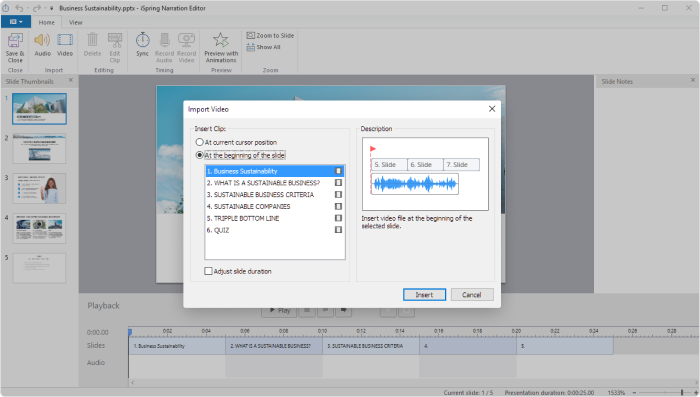
Note: If you choose to import your video at the beginning of a certain slide, you will have the option of selecting the Adjust slide duration option. This will adjust the slide you have selected to the length of your video.
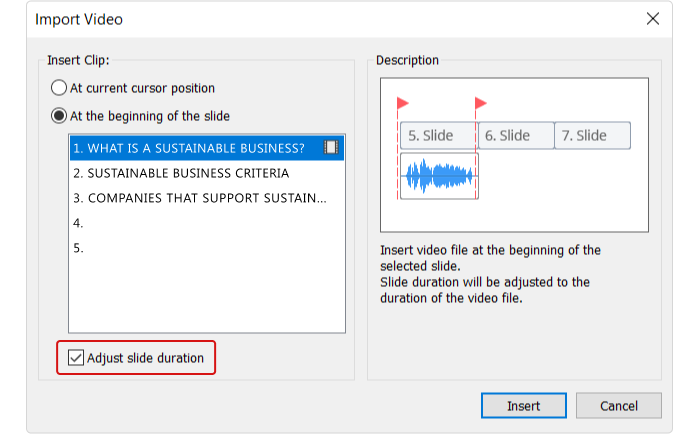
Recording a narration
To record yourself narrating on a webcam, click on the Record Video button on the editor's toolbar.

The Record Video Narration panel will appear.
You can add a video narration for one or several slides at a time. To record video for the current slide, mark Process current slide only.
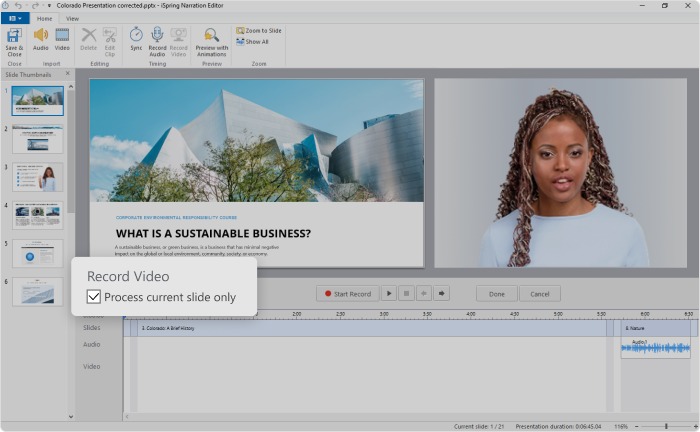
Step 2. Synchronize video with slides
Now it's time to synchronize your video with your slides and animation effects. The latter are displayed as yellow bars on the Slides timeline. The great thing is that you'll be able to choose the exact moment when an animation will appear while watching the video. This way, the effects perfectly correspond to the narration.
Note: This is only applicable if you have animation effects attached to your slides.
The sync process is quite simple to use. Just place the cursor where the sync should begin and click the Sync button on the toolbar.

A Sync panel will appear above the timeline. Click on the Start Sync button to start the process.
The Start Sync button will be replaced with the Next Slide or Next Animation button, depending on the next element in your presentation. Click on those buttons at the appropriate moments. Hit the Next Animation button at the point in the narration where you would like to start the next animation. For example, if you are listing information, you can have each new item appear when the narrator mentions it in the video narration.
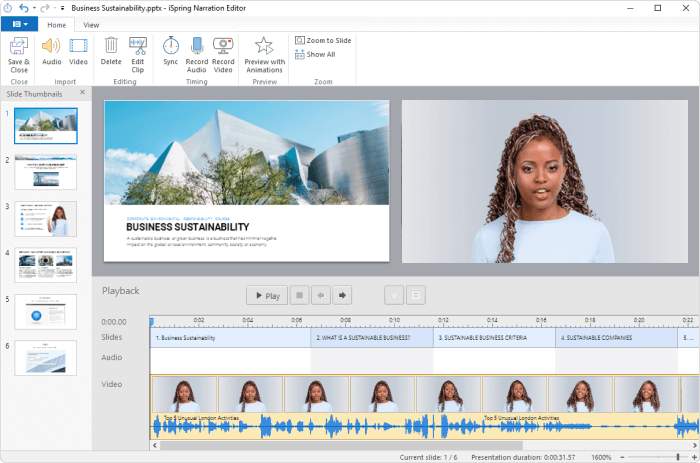
Once you have finished, click on Done to quit the Sync mode. Then hit the Save & Close button in the upper-left corner.
Step 3. Switch layouts in slide properties
iSpring allows you to publish materials using one of two players: the highly customizable Universal player or the Video Lecture player, which displays the presentation in a 50/50 layout and allows viewers to change the proportion between video and slides at any time.
The Universal player features three layouts:
- The Full layout displays the slide, sidebar, and navigation panel.
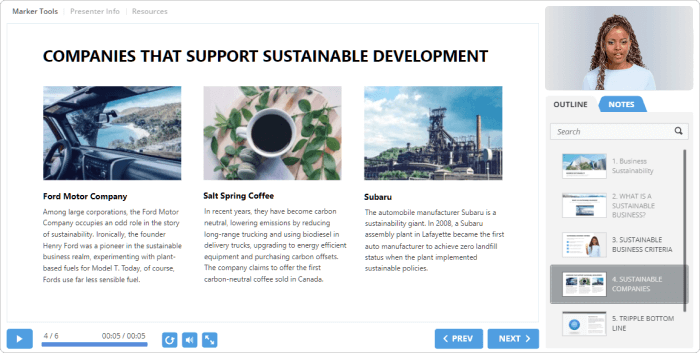
The No Sidebar layout displays the slide and the navigation panel only.
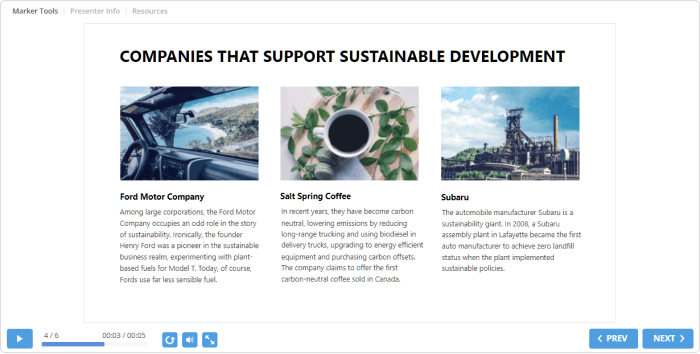
The Maximized Video layout displays the video in the center, the slide on the sidebar, and the navigation panel.

Your presentation doesn't have to have the same layout for all the slides. You can highlight key points by changing the proportion between presentation information and the video for each slide. To do that, click on Slide Properties on the toolbar.

In the Layout column, choose the desired layout for a particular slide from the drop-down list.
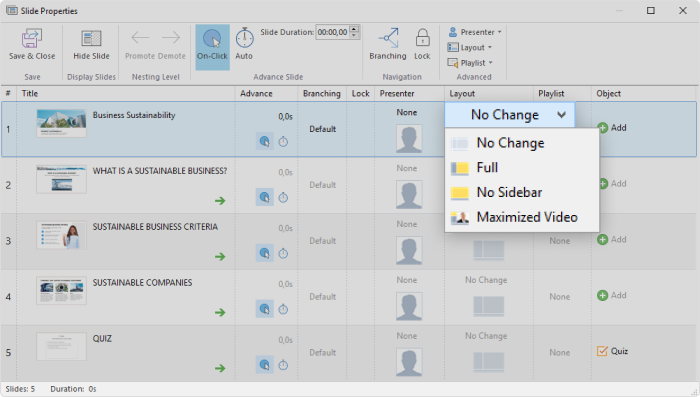
The layouts for the Video Lecture player can be changed at any time during presentation playback. You can still preset them, and they will work as follows:
- The Full layout displays video and slides in equal proportions.
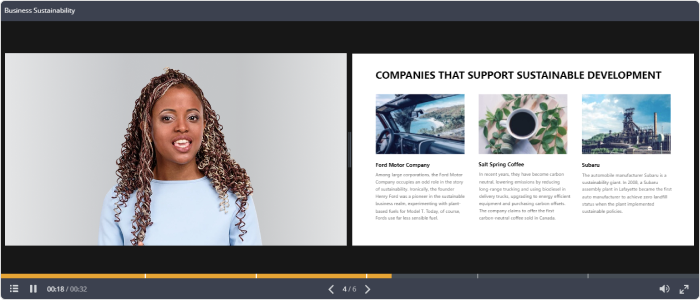
The No Sidebar layout displays the full slide with a miniaturized video.
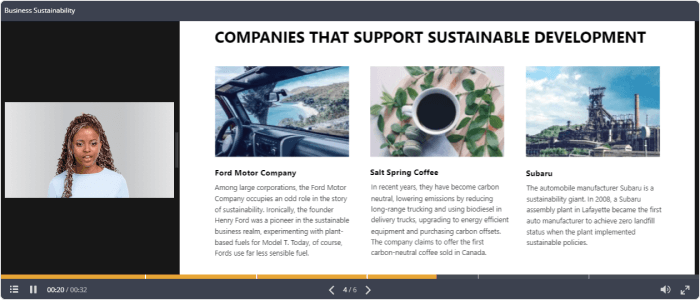
The Maximized Video layout will show the enlarged video and a smaller slide.
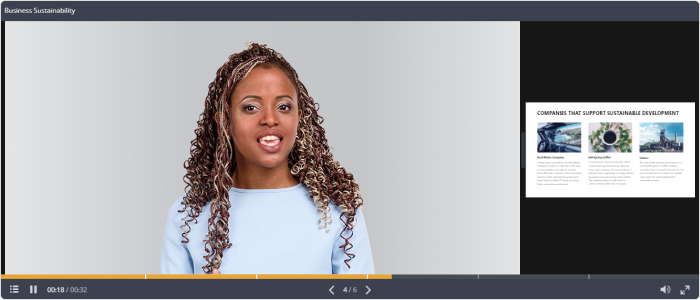
It is insisted that you set slides to advance automatically for the entire presentation. To do that, in the Presentation Explorer, select all slides and click on the Auto button.
Step 4. Customize your player template
The built-in presentation player has flexible customization options: you can provide your viewers with the presenter's info, a company logo, outline, and more. First, let's choose what player to use. Click on Player on the product ribbon, and choose whether to use the Universal or Video Lecture player, as shown in the picture.
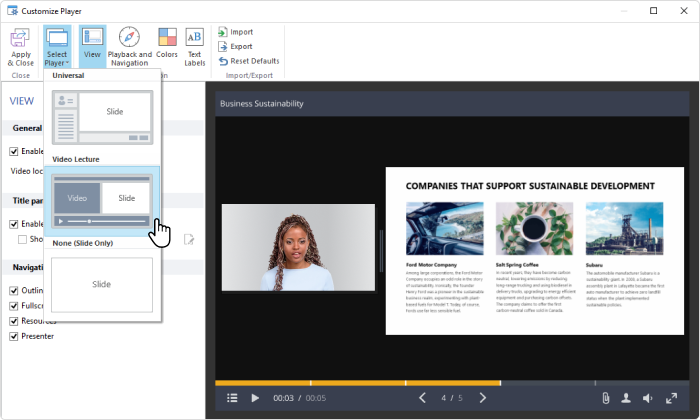
For this guide, we will use the Universal player. To customize it, click on Templates. There are a number of player templates to choose from. We will use the Online Lecture with Video template as an example.
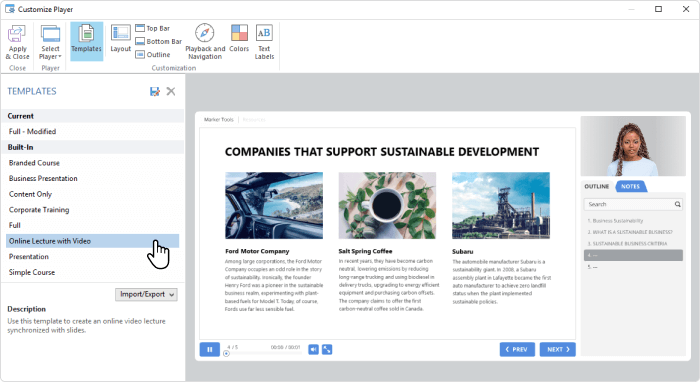
You can also experiment with the settings, doing things like turning off the outline and notes by clicking on the Layout button on the ribbon. Here's what our player will look like:
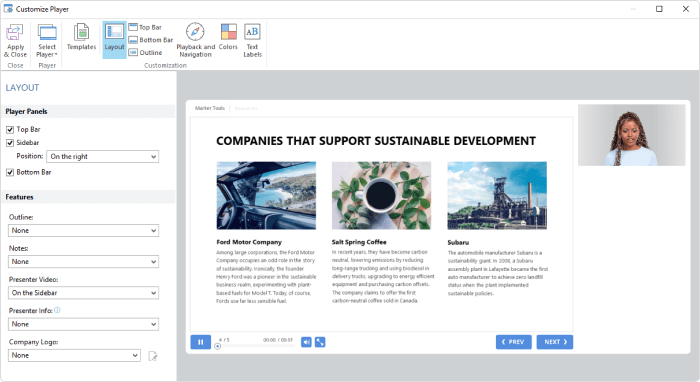
Additionally, you can customize a presentation to match your corporate colors by choosing one of the built-in color schemes or creating your own.
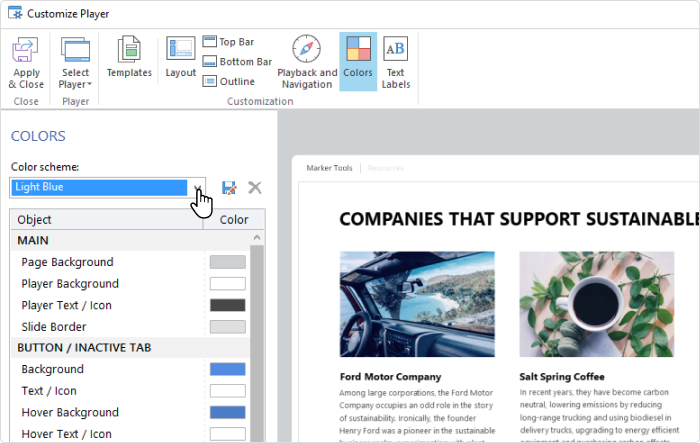
When you've finished customizing the player, click on Apply & Close in the upper left corner.
Step 5. Publish your video presentation
When your video presentation is ready, the last step is to publish it to web format so it can be easily accessed via a browser.
In the Publish Presentation window, select the My Computer tab from the left-hand menu. Enter the presentation title and select a Local folder where the presentation will be saved. Under Output Options, choose a format. We'll be publishing to HTML5 format to make our video presentation play seamlessly across all platforms and devices. You can learn more about publishing presentations here.
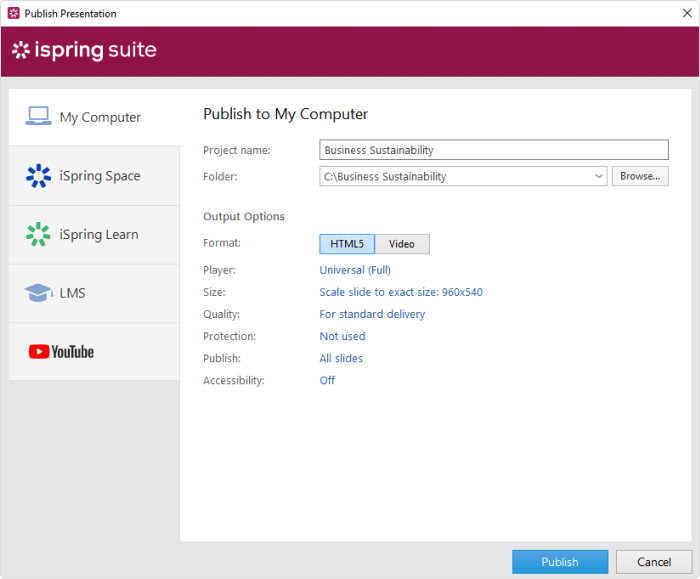
The Top 5 Tools for Making Video Presentations
If you don't feel that iSpring Suite is the right fit for you, there are other tools available that also come with a shallow learning curve. They range from video recording software all the way to animating your own cartoons. Here's an overview of five of the most powerful yet still easy-to-learn video presentation tools.
1. Camtasia
If you want to create a video presentation but don't have the time to put layouts together, you can use the Camtasia video recorder software. Camtasia offers a library of templates that users can use to build their own video projects. Users can also create their own templates and save them for later projects. Like iSpring, Camtasia allows you to record both screen and webcam. You can't create slides in it, but it's a good solution if you need to record and show yourself as well as everything you do on your computer monitor.
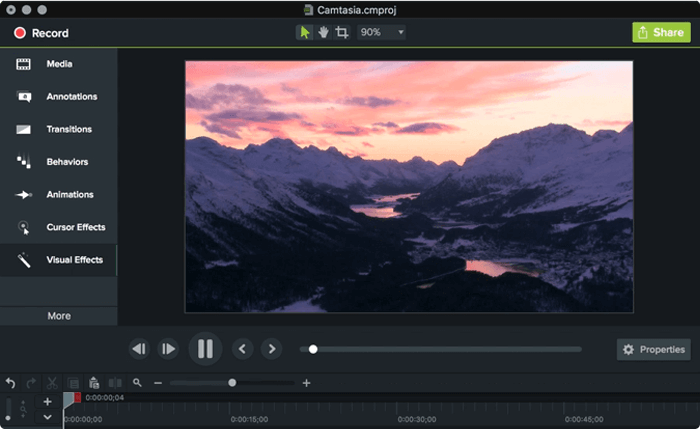
2. PowToon
Animation is a universal language: everybody loves it. Promotional cartoons are now available to everyone, thanks to software tools like PowToon. The service has an intuitive user interface and amazing comic graphics. You can start from scratch or use ready-made scenes and layouts that are editable with a drag-and-drop feature. The final animated presentation can then be uploaded to YouTube, Facebook, and Twitter with one click.
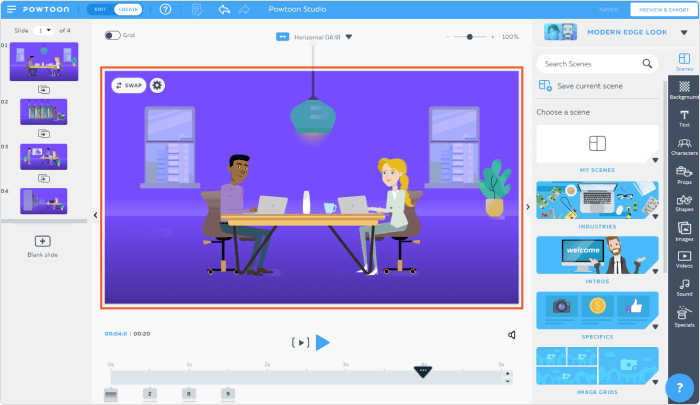
3. Biteable
Biteable allows you to make professional-quality video presentations online in minutes. It sacrifices the ability to capture video and record voice overs for fully animated video. The ingredients are your own photos, texts, pre-made templates, and stock video footage. The styles of videos produced vary from animated graphics to live action. The really cool thing about this tool is the ability to make video infographics.
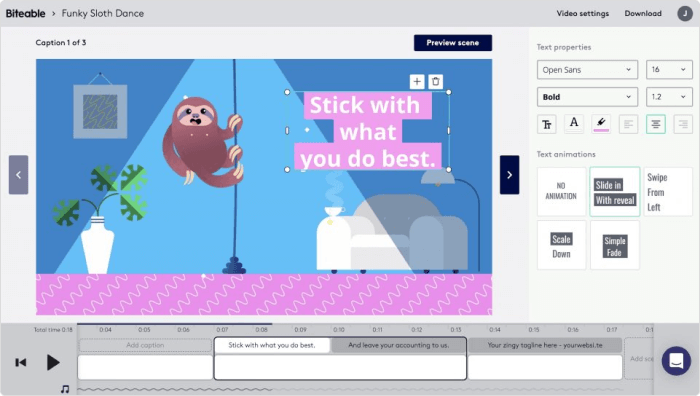
4. Emaze
With Emaze, spectacular visual presentations are at your fingertips. With an intuitive creator interface and a number of ready-made templates available, creating a presentation is both easy and time efficient. If you already have a PowerPoint presentation that you want to enhance, you can import it into Emaze and use its collection of tools – attaching images, GIFs, videos, and 3-D images.
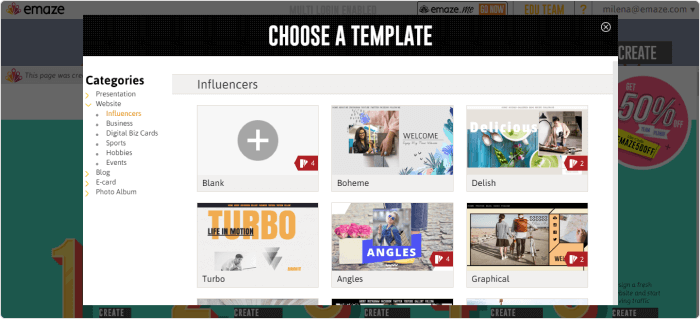
5. Animoto
Animoto is an online video maker that allows you to create video presentations by simply dragging and dropping your own images and video clips into pre-built templates. To customize your videos, you can quickly adjust colors, fonts, music, add your company watermark, and more. No video editing experience is required.
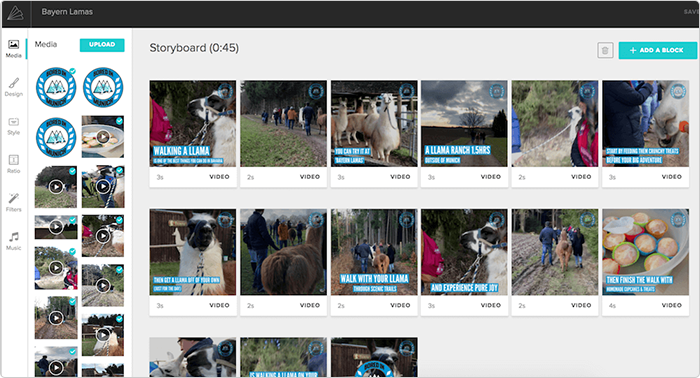
If you'd like to know more about other tools for making video presentations, read our article on the Top 10 Video Presentation Makers for Promotion and Education.
How to Turn Your PowerPoint Presentation into a Video
By default, you can make your PowerPoint presentation into a video by saving it as one. It can be a solid choice if you don't need narration for this video. But if you need to, you'll still be able to record narrations from that menu, without going back to the original PowerPoint presentation.
Here's what you need to do to download your slides as a video in PowerPoint:
- With the presentation open, head over to File on the PowerPoint toolbar and select Export to view the export options.
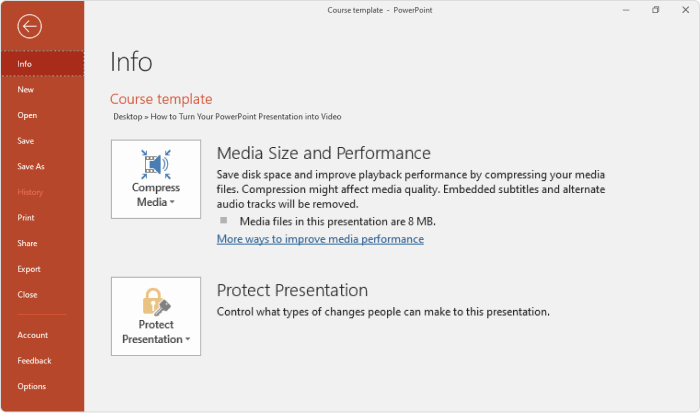
- In the Export menu, select Create a Video. You are now ready to save the presentation as a video.
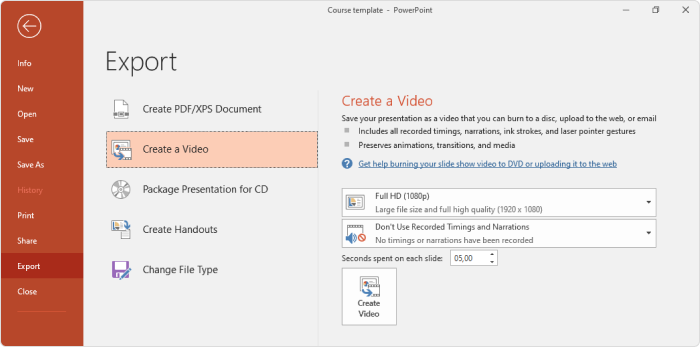
- In the drop-down menu, you can choose how to export the presentation: with narration (if you've already recorded it) or without. If you want to record a narration at this point, click 'Record Timings and Narration.'
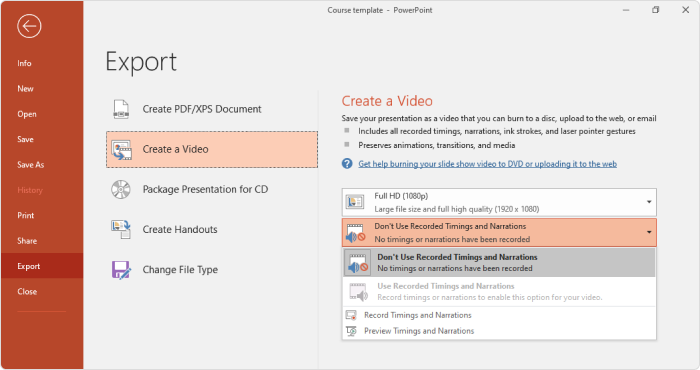
- Choose how long each of your slides will appear. Manage the speed of the demonstration in the small drop-down menu.
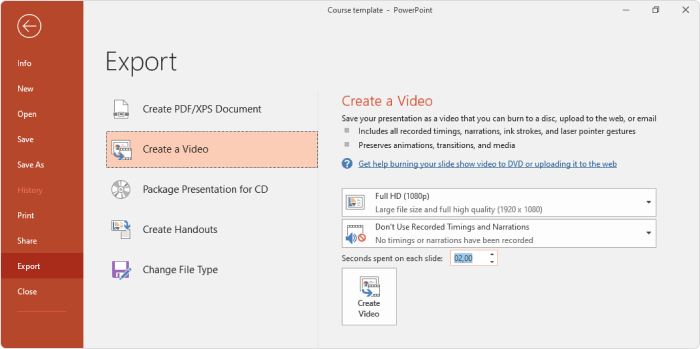
- Click on the Create video tab to start downloading your video.
Tips and Best Practices for Making Video Presentations
To make your presentation even better, consider the following tips for creating a successful video presentation:
- Make your videos short and sweet. Keep your video clips long enough to captivate your audience's attention, but short enough to incite curiosity. Your goal is to maintain the viewer's interest. Remember, the optimal length is 4-7 minutes.
- Keep to the point. Make your goals and objectives known at the start of the presentation and don't stray from the message. Your text and visuals should relate to the subject matter and not detract from the goal of your video presentation.
- Add engaging elements. Enrich your video presentation with useful and interesting content. For example, add music, embed YouTube videos, or insert interactive quizzes.
- End on a meaningful note. Leave your audience with something they can take away from the presentation. An idea, a visual representation of your product, or even a link to your website works to provide the strong ending needed to create a lasting impression.
FAQ on Video Presentations
How do I make an effective video presentation?
First and foremost, think about your audience. What are their ages, genders, and occupations? What is their prior knowledge on a topic or their level of proficiency? After you define this, choose the way you will present accordingly. You should connect with your audience emotionally and 'speak their language.' In this way, you'll communicate knowledge and the right message to your learners.
Second, it will be useful to prepare a script for your video. Of course, the slides will support you, and you can base your speech on their content. But if you write an introduction, some key points, and transition words in advance, you will feel more confident, and reduce rambling or unnecessary pauses. This will help you focus on the effectiveness of your words.
How can I prepare myself for a video presentation?
Make sure you're physically and technically ready. When speaking, prevent your mouth and throat from getting dry. You can use a lip balm and have a glass of water nearby to refresh during pauses. This will make you sound better, and your recording will be clearer. For recording, it's better to choose a smaller quiet space to avoid echoes, and check your microphone sound.
What is the best video format for a PowerPoint presentation?
PowerPoint allows you to save your presentation in these video formats: MPEG-4 (or MP4 / .mp4), Windows Media Video (.wmv) or MOV (if it's PowerPoint on a Mac). MPEG-4 is the most common video format and is widely supported. Opt for this if you have PowerPoint versions 2013, 2016, or 2019. With PowerPoint 2010, the Windows Media format is preferable.
To Sum Up
We hope this post will help you turn a PowerPoint presentation into an engaging video lecture. To start creating video presentations and other kinds of eLearning content, try iSpring Suite now. Get a 30-day trial and access all of its features without spending a cent.
How To Create Cool Powerpoint Presentations
Source: https://www.ispringsolutions.com/blog/how-to-create-a-video-presentation-with-ispring-presenter
Posted by: hangersaisuatecous1950.blogspot.com

0 Response to "How To Create Cool Powerpoint Presentations"
Post a Comment